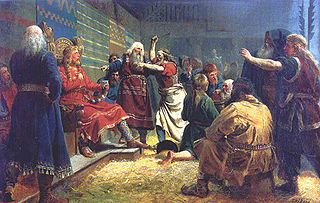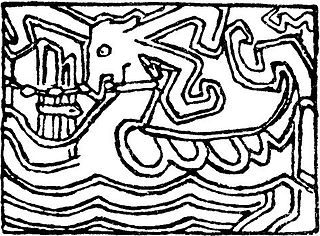Related Research Articles

Harald Fairhair was a Norwegian king. According to traditions current in Norway and Iceland in the eleventh and twelfth centuries, he reigned from c. 872 to 930 and was the first King of Norway. Supposedly, two of his sons, Eric Bloodaxe and Haakon the Good, succeeded Harald to become kings after his death.

Harald Sigurdsson, also known as Harald III of Norway and given the epithet Hardrada in the sagas, was King of Norway from 1046 to 1066. He unsuccessfully claimed the Danish throne until 1064 and the English throne in 1066. Before becoming king, Harald spent 15 years in exile as a mercenary and military commander in Kievan Rus' and chief of the Varangian Guard in the Byzantine Empire. In his chronicle, Adam of Bremen called him the "Thunderbolt of the North".

Haakon Haraldsson, also Haakon the Good and Haakon Adalsteinfostre, was the king of Norway from 934 to 961. He was noted for his attempts to introduce Christianity into Norway.

Sigurd Håkonsson was a Norwegian nobleman and Jarl of Lade in Trøndelag.
Guttorm Haraldsson was the first son of King Harald Fairhair of Norway and Åsa, daughter of Håkon Grjotgardsson, who was the first Earl of Lade.

The Battle of Hafrsfjord was a naval battle fought in Hafrsfjord sometime between 872 and 900 that resulted in the unification of Norway, later known as the Kingdom of Norway. After the battle, the victorious Viking chief Harald Fairhair proclaimed himself the first king of the Norwegians, merging several petty kingdoms under a single monarch for the first time.
Ketill Björnsson, nicknamed Flatnose, was a Norse King of the Isles of the 9th century.

The Jomsvikings were a legendary order of Viking mercenaries or conquerors of the 10th and 11th centuries. Though reputed to be staunchly dedicated to the worship of the Old Norse gods, they would allegedly fight for any lord who could pay their substantial fees, even if they may be Christian. The institution of the Jomsvikings would itself foreshadow those of the later religious and chivalric orders of the Middle Ages.

The Battle of Rastarkalv took place in 955 on the southern part of the island of Frei in the present-day Kristiansund Municipality in Møre og Romsdal county, Norway.

Battle of Nesjar was a sea battle off the coast of Norway in 1016. It was a primary event in the reign of King Olav Haraldsson. Icelandic skald and court poet Sigvatr Þórðarson composed the poem Nesjavísur in memory of the battle. A monument known as the Nesjar Monument was erected on the 1000th anniversary of the battle, located in Helgeroa village in Larvik, Vestfold County, where the battle is believed to have occurred.

The Battle of Helgeå, or Battle of the Holy River, was a naval engagement which took place in 1026 between joint Danish and English forces and a combined Norwegian and Swedish force, at the estuary of a river called Helge in Sweden or Denmark.

The Battle of Hjǫrungavágr is a semi-legendary naval battle that took place in the late 10th century between the Jarls of Lade and a Danish invasion fleet led by the fabled Jomsvikings. This battle played an important role in the struggle by Haakon Sigurdsson to unite his rule over Norway. Traditionally, the battle has been set during the year 986.

The civil war era in Norway began in 1130 and ended in 1240. During this time in Norwegian history, some two dozen rival kings and pretenders waged wars to claim the throne.

Glymdrápa is a skaldic poem composed by Þorbjörn Hornklofi, the court poet of King Harald I of Norway. Composed toward the end of the 9th century, the poem recounts several battles waged by King Harald, mostly as he was uniting Norway.

Gunnhildr konungamóðir or Gunnhildr Gormsdóttir, whose name is often Anglicised as Gunnhild, is a quasi-historical figure who appears in the Icelandic Sagas, according to which she was the wife of Eric Bloodaxe. She appears prominently in sagas such as Fagrskinna, Egils saga, Njáls saga, and Heimskringla.
Huntjov was according to Snorri Sturluson king in Nordmøre before and during Harald Fairhair's wars of conquest. Together with his son Solve Klove and his father-in-law, king Nokkve of Romsdal, he led an army to stop king Harald from advancing south from Trøndelag. At the first battle of Solskjell both kings fell, and their kingdoms were taken by Harald.
The second battle of Solskjell was an engagement in Harald Fairhair's conquest of Norway.

The Unification of Norway is the process by which Norway merged from several petty kingdoms into a single kingdom, predecessor to the modern Kingdom of Norway.

The Battle of Holmengrå was a naval battle fought on 12 November 1139 near the island Holmengrå south of Hvaler, between the forces of the child kings Sigurd Haraldsson and Inge Haraldsson on the one side, and on the other side the pretender Sigurd Slembe and his ally King Magnus the Blind. Inge and Sigurd Haraldsson were sons of the previous king Harald Gille, who had been killed by Sigurd Slembe in 1136. The sons of Harald Gille emerged victorious from the battle. Magnus the Blind was killed in action, while Sigurd Slembe was betrayed, captured, and later tortured and executed.
Audbjörn Frøybjørnsson was the King of the Kingdom of Firda. One of the petty kingdoms of Norway during the Viking age. He lived approximately between 840 and 870.